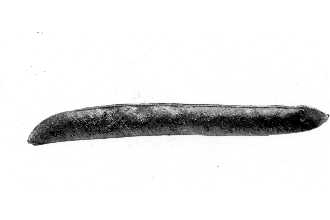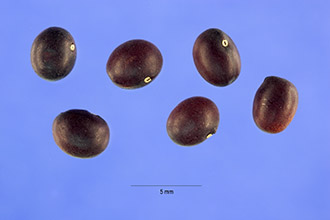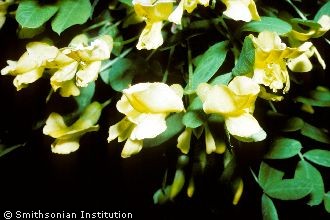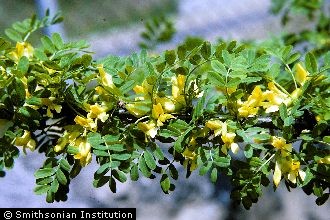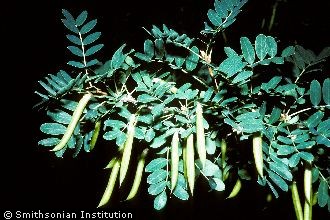Siberian Peashrub
Scientific Name: Caragana arborescens Lam.
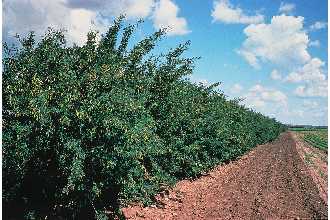
| General Information | |
|---|---|
| Usda Symbol | CAAR18 |
| Group | Dicot |
| Life Cycle | Perennial |
| Growth Habits | ShrubTree, |
| Native Locations | CAAR18 |
Plant Guide
Alternative Names
Ross caragana, Siberian pea tree, pea-tree , Use soil moisture sensors to measure the soil moisture of Siberian Peashrub.
Uses
Medicinal: The plant is used for cancer of the breast, the orifice to the womb, and other gynecological problems (Kiangsu 1977). Wildlife: During World War II, the Siberian peasants reportedly carried their chicken flocks through the winter by feeding them Caragana arborscens seeds (Snell 1983). The seeds serve as valuable food for wild life. It also provides cover for upland game. Agroforestry: Caragana arborscens has been recommended as a nitrogen-fixing windbreaker and groundcover plant that binds the soil and produce fiber and dye. It is often used as a single row field shelterbelt for borders, screen plantings, or flowering hedges. Other uses: Some ethnic groups have used young pods for vegetables. The bark provides a fiber and the leaves yield an azure dye. The wood is used for woodturning.
Status
Introduced into the U.S. Please consult the PLANTS Web site and your State Department of Natural Resources for this plant’s current status, such as, state noxious status and wetland indicator values. Conservation Trees & Shrubs for Montana USDA, NRCS, Montana State Office
Description
General: Pea Family (Fabaceae). Siberian peashrub is an introduced, deciduous shrub or small tree ranging between ten to fifteen feet tall. The leaves are alternate, three to five inches long, with each leaf composed of eight to twelve oval leaflets. The flowers are yellow and appear early in the season forming pods in late June or early July. As the pods ripen, they crack and burst, spreading the seeds. The young bark is smooth and olive green and becomes less vivid in color as the bark ages. Distribution: Siberian peashrub is native to Siberia and Manchuria. In the United States, its growth is stunted south of Nebraska. For current distribution, please consult the Plant profile page for this species on the PLANTS Web site.
Adaptation
Siberian peashrub succeeds in most well drained soils. It prefers full sun but can tolerate some shade. This species is very tolerant of infertile soils, cold winter temperatures, and drought conditions. It tolerates alkaline soils and deicing salt. This plant’s chief value is its ability to adapt to poor sites. It also requires little maintenance.
Establishment
Propagation by Seed: Seed is best sown as soon as it is ripe in a cold frame. Stored seeds should be pre-soaked twenty-four hours in warm water and then sown in a cold frame. If the seeds do not swell, then stratify them and re-soak for another twelve hours before sowing. Germination should occur in two to three weeks at 20ºC. Certain pesticides can increase germination possibly by inhibiting disease. Propagation by cuttings: Layering should be done in the spring. Cuttings should consist of half ripe wood, three to four inches with a heel, and should be done between July and August. Grafting the cultivars, especially ‘Pendula’, ‘Lorbergii’, and ‘Walker’, are top worked at four to six inches height on Caragana arborscens seedlings (Dirr & Heuser 1987). Root cuttings, layering or grafting can also propagate Caragana arborscens.
Management
General: Siberian peashrub is susceptible to leaf spot diseases, red spider mites, blister beetles, grasshoppers, and aphids, which leads to poor foliage quality in mid to late summer. Cultivars, Improved and Selected Materials (and area of origin) ‘Sutherland’, Lorbergii’, ‘Pendula’, ‘Walker’, and ‘Nana’ are cultivars of Siberian peashrub. ‘Sutherland’ has a narrow, upright form. ‘Lorbergii’ has a graceful form with fine textured leaves. ‘Pendula’ has a stiffly weeping form with arching branches. ‘Walker’ is much like ‘Lorbergii’ in leaf character but strongly weeping (Dirr 1990). ‘Nana’ has a dwarf form with somewhat contorted branches. Consult your local nurseries to choose the right cultivar for your specific landscape. Contact your local Natural Resources Conservation Service (formerly Soil Conservation Service) office for more information. Look in the phone book under ”United States Government.” The Natural Resources Conservation Service will be listed under the subheading “Department of Agriculture.”
References
Agriculture Handbook. 450. 1974. Seeds of woody plants in the U.S. Forest Service, USDA. Washington DC. Bruggen, T.V. 1976. The vascular plants of South Dakota. The Iowa State University Press, Ames, Iowa. Bush-Brown, J. 1963. Shrubs and trees for the home landscape. Chilton Company, Philadelphia, Pennsylvania. Great Plains Flora Association. 1986. Flora of the Great Plains. University Press of Kansas, Lawerence, Kansas. Dirr, M.A. 1990. Manual of woody landscape plants: their identification, ornamental characteristics, culture, propagation, and uses. 4th ed. Stipes Publishing Company, Champaign, Illinois. Dirr, M.A. & C.W. Heuser, Jr. 1987. The reference manual of woody plant propagation: from seed to tissue culture. Varsity Press, Athens, Georgia. Kiangsu-Institude of Modern Medicine. 1977. Encyclopedia of Chinese drugs. 2 vols. Shanghai, China. Preston, R.J. Jr. 1948. North American trees. 2nd ed. The Iowa State College Press, Ames, Iowa. Rosendahl, C.O. 1955. Trees and shrubs of the upper Midwest. University of Minnesota Press, Minneapolis, Minnesota. Rehder, A. 1940. Manual of cultivated trees and shrubs: hardy in North America. 2nd ed. The Macmillan Company, New York, New York. Snell, T. 1983. Caragana: The pea shrubs. In: The International Permaculture Seed Yearbook. Orange, Massachusetts. Taylor, N. 1965. The guide to garden shrubs and trees. Houghton Mifflin Company, Boston Massachusetts. USDA, NRCS 2000. Conservation trees and shrubs for Montana. Custer County Soil
Conservation
District. Accessed: 11jan02. <http://www.mt.nrcs.usda.gov/pas/forestry/caragana. html>
Plant Traits
Growth Requirements
| Cold Stratification Required | Yes |
|---|---|
| Hedge Tolerance | Medium |
| Hedge Tolerance | Medium |
| Frost Free Days, Minimum | 160 |
| Frost Free Days, Minimum | 150 |
| Fire Tolerance | Low |
| Fertility Requirement | Medium |
| Fertility Requirement | Low |
| Drought Tolerance | High |
| Drought Tolerance | High |
| Cold Stratification Required | Yes |
| Temperature, Minimum (°F) | -38 |
| CaCO3 Tolerance | High |
| CaCO3 Tolerance | High |
| Anaerobic Tolerance | Low |
| Anaerobic Tolerance | Low |
| Adapted to Medium Textured Soils | Yes |
| Adapted to Medium Textured Soils | Yes |
| Adapted to Fine Textured Soils | Yes |
| Adapted to Fine Textured Soils | Yes |
| Adapted to Coarse Textured Soils | Yes |
| Adapted to Coarse Textured Soils | No |
| Moisture Use | Medium |
| Temperature, Minimum (°F) | -38 |
| Shade Tolerance | Intolerant |
| Shade Tolerance | Intermediate |
| Salinity Tolerance | Medium |
| Salinity Tolerance | Medium |
| Root Depth, Minimum (inches) | 16 |
| Root Depth, Minimum (inches) | 16 |
| Precipitation, Minimum | 12 |
| Precipitation, Minimum | 10 |
| Precipitation, Maximum | 55 |
| Precipitation, Maximum | 35 |
| Planting Density per Acre, Minim | 700 |
| Planting Density per Acre, Minim | 1212 |
| Planting Density per Acre, Maxim | 2728 |
| Planting Density per Acre, Maxim | 1700 |
| pH, Minimum | 6.0 |
| pH, Minimum | 5.0 |
| pH, Maximum | 9.0 |
| pH, Maximum | 8.5 |
| Moisture Use | Medium |
Morphology/Physiology
| Active Growth Period | Spring, Summer, Fall |
|---|---|
| Toxicity | None |
| Toxicity | None |
| Shape and Orientation | Erect |
| Shape and Orientation | Erect |
| Fire Resistant | No |
| Foliage Texture | Medium |
| Foliage Porosity Winter | Moderate |
| Foliage Porosity Winter | Moderate |
| Foliage Porosity Summer | Dense |
| Foliage Porosity Summer | Dense |
| Foliage Color | Green |
| Foliage Color | Green |
| Flower Conspicuous | Yes |
| Flower Conspicuous | Yes |
| Flower Color | Yellow |
| Flower Color | Yellow |
| Resprout Ability | Yes |
| Fire Resistant | No |
| Fall Conspicuous | No |
| Fall Conspicuous | No |
| Coppice Potential | Yes |
| Coppice Potential | Yes |
| C:N Ratio | Medium |
| C:N Ratio | Medium |
| Bloat | None |
| Bloat | None |
| Active Growth Period | Spring and Summer |
| Resprout Ability | Yes |
| Fruit/Seed Color | Brown |
| Nitrogen Fixation | Medium |
| Nitrogen Fixation | Medium |
| Low Growing Grass | No |
| Low Growing Grass | No |
| Lifespan | Moderate |
| Lifespan | Moderate |
| Leaf Retention | No |
| Leaf Retention | No |
| Known Allelopath | No |
| Known Allelopath | No |
| Height, Mature (feet) | 14.0 |
| Height at 20 Years, Maximum (fee | 14 |
| Height, Mature (feet) | 12.0 |
| Foliage Texture | Medium |
| Fruit/Seed Color | Brown |
| Fruit/Seed Conspicuous | No |
| Fruit/Seed Conspicuous | Yes |
| Growth Form | Multiple Stem |
| Growth Form | Multiple Stem |
| Growth Rate | Rapid |
| Growth Rate | Rapid |
| Height at 20 Years, Maximum (fee | 12 |
Reproduction
| Propagated by Cuttings | No |
|---|---|
| Propagated by Seed | No |
| Propagated by Seed | Yes |
| Propagated by Sod | No |
| Propagated by Sod | No |
| Propagated by Sprigs | No |
| Propagated by Sprigs | No |
| Propagated by Tubers | No |
| Propagated by Tubers | No |
| Seed per Pound | 19000 |
| Fruit/Seed Period End | Summer |
| Seed per Pound | 19000 |
| Seed Spread Rate | Moderate |
| Seed Spread Rate | Moderate |
| Seedling Vigor | Medium |
| Seedling Vigor | Medium |
| Small Grain | No |
| Small Grain | No |
| Vegetative Spread Rate | None |
| Vegetative Spread Rate | None |
| Propagated by Corm | No |
| Propagated by Cuttings | No |
| Bloom Period | Late Spring |
| Bloom Period | Late Spring |
| Commercial Availability | Routinely Available |
| Commercial Availability | Routinely Available |
| Fruit/Seed Abundance | High |
| Fruit/Seed Abundance | High |
| Fruit/Seed Period Begin | Spring |
| Fruit/Seed Period Begin | Spring |
| Fruit/Seed Period End | Summer |
| Fruit/Seed Persistence | No |
| Propagated by Bare Root | Yes |
| Propagated by Bare Root | Yes |
| Propagated by Bulb | No |
| Propagated by Bulb | No |
| Propagated by Container | Yes |
| Propagated by Container | Yes |
| Propagated by Corm | No |
| Fruit/Seed Persistence | No |
Suitability/Use
| Palatable Browse Animal | Low |
|---|---|
| Palatable Graze Animal | Low |
| Palatable Graze Animal | Low |
| Palatable Human | No |
| Palatable Human | No |
| Post Product | No |
| Post Product | No |
| Protein Potential | Low |
| Protein Potential | Low |
| Pulpwood Product | No |
| Pulpwood Product | No |
| Veneer Product | No |
| Veneer Product | No |
| Palatable Browse Animal | Low |
| Nursery Stock Product | Yes |
| Nursery Stock Product | No |
| Naval Store Product | No |
| Naval Store Product | No |
| Lumber Product | No |
| Lumber Product | No |
| Fodder Product | No |
| Fodder Product | No |
| Christmas Tree Product | No |
| Christmas Tree Product | No |
| Berry/Nut/Seed Product | No |
| Berry/Nut/Seed Product | No |

